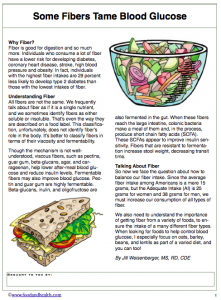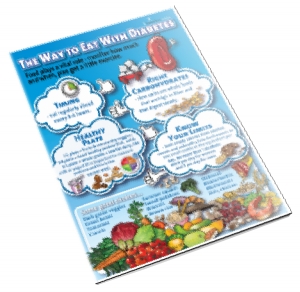Fiber Focus Month: Free Handout
 We're celebrating Fiber Focus Month this January by giving away one of our most popular handouts: Some Fibers Tame Blood Glucose. Here's a little preview...Why Fiber?Fiber is good for digestion and so much more. Individuals who consume a lot of fiber have a lower risk for developing diabetes, coronary heart disease, stroke, high blood pressure, and obesity. In fact, individuals with the highest fiber intakes are 29 percent less likely to develop type 2 diabetes than those with the lowest intakes of fiber.Understanding Fiber:All fibers are not the same. We frequently talk about fiber as if it is a single nutrient, and we sometimes identify fibers as either soluble or insoluble. That’s even the way they are described on a food label. This classification, unfortunately, does not identify fiber’s role in the body. It’s better to classify fibers in terms of their viscosity and fermentability.Though the mechanism is not well-understood, viscous fibers, such as pectins, guar gum, beta-glucans, agar, and carrageenan, help lower after-meal blood glucose and reduce insulin levels. Fermentable fibers may also improve blood glucose. Pectin and guar gum are highly fermentable. Beta-glucans, inulin, and oligofructose are also fermented in the gut. When these fibers reach the large intestine, colonic bacteria make a meal of them and, in the process, produce short chain fatty acids (SCFA). These SCFAs appear to improve insulin sensitivity. Fibers that are resistant to fermentation increase stool weight, decreasing transit time.For the rest of this amazing handout by Jill Weisenberger, MS, RD, CDE, download the PDF today!We've got tons of great handouts in the Nutrition Education Store too! Take a look at these top sellers...
We're celebrating Fiber Focus Month this January by giving away one of our most popular handouts: Some Fibers Tame Blood Glucose. Here's a little preview...Why Fiber?Fiber is good for digestion and so much more. Individuals who consume a lot of fiber have a lower risk for developing diabetes, coronary heart disease, stroke, high blood pressure, and obesity. In fact, individuals with the highest fiber intakes are 29 percent less likely to develop type 2 diabetes than those with the lowest intakes of fiber.Understanding Fiber:All fibers are not the same. We frequently talk about fiber as if it is a single nutrient, and we sometimes identify fibers as either soluble or insoluble. That’s even the way they are described on a food label. This classification, unfortunately, does not identify fiber’s role in the body. It’s better to classify fibers in terms of their viscosity and fermentability.Though the mechanism is not well-understood, viscous fibers, such as pectins, guar gum, beta-glucans, agar, and carrageenan, help lower after-meal blood glucose and reduce insulin levels. Fermentable fibers may also improve blood glucose. Pectin and guar gum are highly fermentable. Beta-glucans, inulin, and oligofructose are also fermented in the gut. When these fibers reach the large intestine, colonic bacteria make a meal of them and, in the process, produce short chain fatty acids (SCFA). These SCFAs appear to improve insulin sensitivity. Fibers that are resistant to fermentation increase stool weight, decreasing transit time.For the rest of this amazing handout by Jill Weisenberger, MS, RD, CDE, download the PDF today!We've got tons of great handouts in the Nutrition Education Store too! Take a look at these top sellers...




